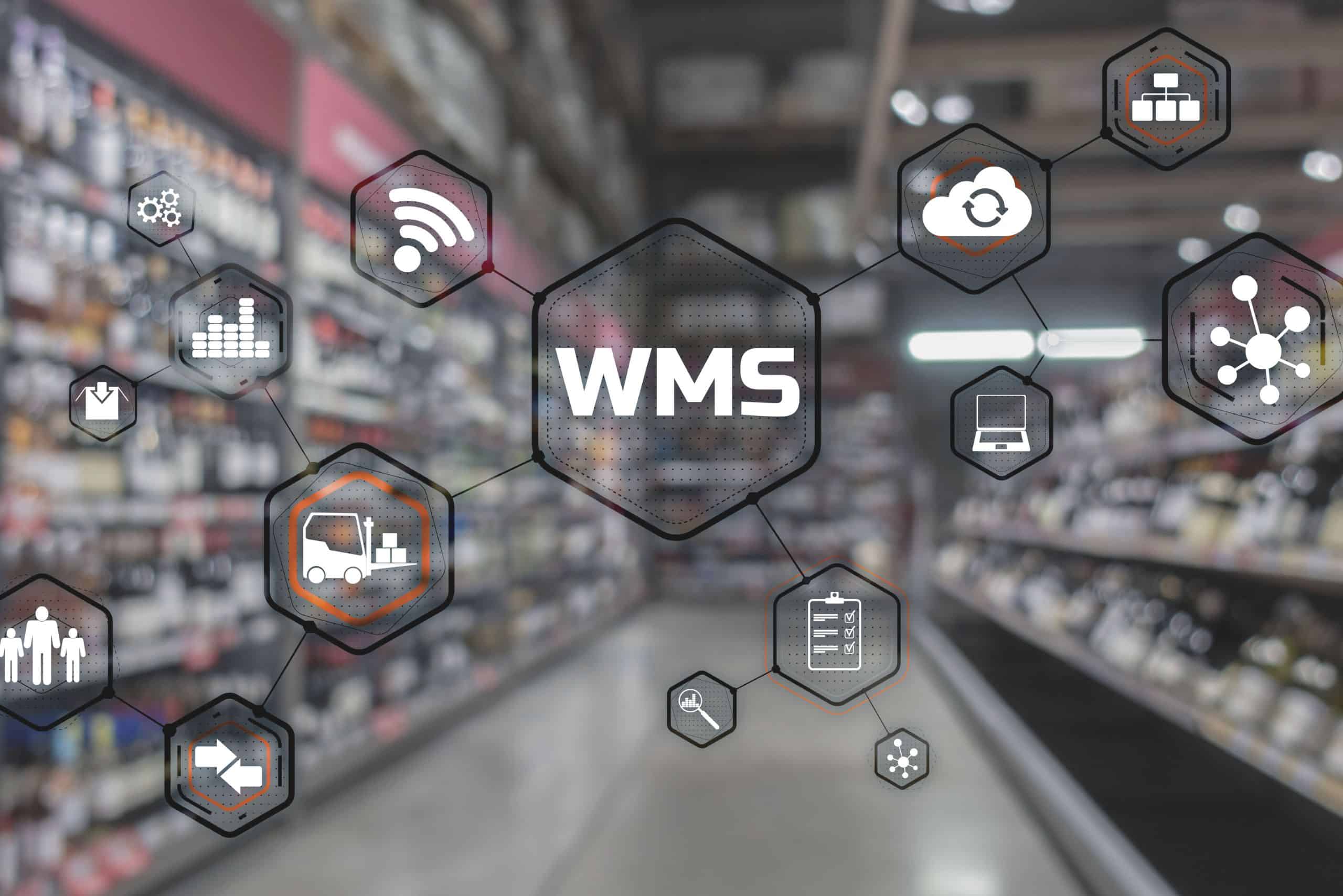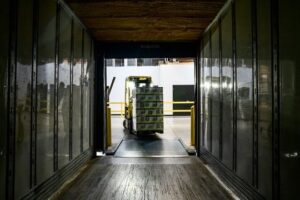What is a Warehouse Management System (WMS)?
WMS software
Logistics
Supply Chain
October 4, 2024

WMS: everything you need to know about the Warehouse Management System
In the complex world of logistics, understanding what a Warehouse Management System (WMS) is is essential for optimizing warehouse operations, improving efficiency, and reducing costs. This inventory management plays a crucial role in coordinating and automating processes , thus ensuring better visibility into the flow of goods. WMS software with advanced features meets increasingly demanding logistics requirements by offering an effective solution for managing the movement and storage of products within warehouses.
This article aims to explore in detail the fundamental aspects of a WMS, from its definition and advantages to the key steps of its implementation. We will also discuss best practices for optimizing its use and examine future trends that will shape the evolution of warehouse management systems. Through these sections, you will discover how a WMS solution can transform warehouse management into a competitive advantage by focusing on the continuous improvement of logistics performance.
Understanding the basics of a WMS
Warehouse management systems ( WMS) play a key role in optimizing logistics operations inventory management . These systems allow businesses to manage their warehouses efficiently by automating and streamlining a wide range of processes.
How a WMS works
A WMS or Warehouse Management System is software intended to facilitate the management of warehouse operations . It ensures reception , storage , stock management , inventories , order preparation and shipping of goods. The software enables detailed management through precise mapping of the warehouse environment where every location and item is clearly defined and tracked. This fine-grained management of physical units makes it possible to improve the scheduling of operations and monitor the status of orders in real time , thus increasing productivity and quality of service.
The different types of WMS
There are several types of WMS suited to different business needs and contexts:
- WMS Standalone : This type of software focuses exclusively on managing warehouse operations without being tied to other IT systems.
- WMS ERP (Enterprise Resource Planning) : Integrated into a larger ERP WMS provides data synchronization between warehouse operations and other business functions like accounting , sales , and purchasing .
- WMS Cloud cloud platform , this WMS provides accessibility via the Internet allowing increased flexibility for users who can access the system from anywhere.
- Open Source WMS : Based on free software , this type of WMS can be modified by the developer community offering customization according to specific needs without the constraints of proprietary solutions.
Each of these systems offers specific advantages and is chosen according to the precise needs of the company and its logistics strategy.
The benefits of a WMS for warehouse management
Adopting a warehouse management system (WMS) offers significant benefits to optimize the management of storage and distribution operations. These benefits manifest through several aspects of warehouse management .
Operational efficiency
A WMS increases operational efficiency by automating manual tasks, reducing errors and speeding up operations. It optimizes storage space usage by identifying available locations and maximizing storage capacity. These improvements enable businesses to improve operational efficiency, reduce costs and increase productivity.
Product traceability
Product traceability is essential to ensure regulatory compliance and meet customer requirements. A WMS allows each item to be precisely tracked from receipt to shipment. In the event of a product recall or quality issue, affected batches can be quickly identified and appropriate action taken. Better product traceability builds customer trust and protects company reputation.
Improved ROI
Implementing a WMS can lead to a significant improvement in return on investment (ROI) thanks to reduced management costs and improved customer relations. The ROI of WMS is often seen in less than a year, making it a worthwhile investment for many businesses.
These benefits demonstrate how a WMS can transform the efficiency and profitability of warehouse operations by delivering tangible gains that directly affect overall business performance.
Implementing a WMS: key steps
Implementing a warehouse management system (WMS) requires careful planning and execution to ensure success. Here are the key steps for effective implementation:
Needs analysis
The first step in implementing a WMS is analyzing the specific needs of the business. This involves understanding existing processes, challenges and functionality needed to choose the most suitable solution. A functional audit of the facility will identify problem areas and create a list of necessary changes.
Software selection
The choice of WMS should be based on several criteria, including the size of the warehouse , the complexity of operations and the required functionalities . It is crucial to select a system that can easily integrate with other tools used by the company such as ERP or TMS . The robustness and performance of the WMS are also important factors, especially for companies that manage large volumes of orders or experience peaks in activity.
Data migration
Data migration is a critical stage of implementation. It must be carried out carefully to avoid data loss and guarantee continuity of operations. A migration strategy must be put in place including data backup, cleaning and integration into the new system. It is also important to test the system after migration to ensure that all features are working properly and the data is accurate.
These steps, although complex, are a prerequisite for ensuring that the WMS performs optimally and delivers the expected improvements in the efficiency and profitability of warehouse operations.
Best practices for using a WMS
To maximize the efficiency and profitability of a WMS (Warehouse Management System) , it is advisable to adopt the best practices :
Continuing education
Employee training is crucial for optimal use of the WMS . It is essential that staff are regularly trained on system features and updates to ensure maximum performance. continuing education sessions allows users to stay up to date on new features and optimize their use of the system.
Update management
A WMS must be regularly updated to adapt to market developments and new technologies. These updates may include new features that improve operational efficiency or fix existing bugs. It is therefore essential to evaluate and implement these updates in a timely manner to keep the system efficient and secure .
Monitoring and evaluation
To ensure effective use of WMS , it is necessary to monitor its performance and identify areas requiring improvement. Using the data and reports generated by the WMS allows you to measure the efficiency of logistics operations and make necessary adjustments. This includes analyzing inventory levels , inventory turnover rates , order processing times , and customer satisfaction .
These practices ensure that the WMS remains a strategic tool contributing to the efficiency and competitiveness of the company in the management of its warehouse operations.
Future Trends in WMS
Automation
Automation maximizing storage space and matching supply to demand through programmable systems that evolve with the market. The implementation of 5G will further accelerate these technologies, enabling more efficient collaboration between robots, software and operators. This results in increased productivity and a higher number of orders processed daily requiring WMS capable of efficiently handling an increased volume of information.
Artificial intelligence
intelligence (AI) is revolutionizing warehouse management by enabling machines to replicate human decisions and optimize production processes. Advances in AI , including machine learning and neural networks , make it easier to analyze large data sets to improve logistics decisions. AI embedded in WMS helps predict the time needed to prepare orders and optimizes picking routes thereby increasing efficiency and reducing costs.
IoT integration
The Internet of Things (IoT) is becoming a central element in modern warehouses, providing increased interconnection between equipment and management systems. IoT innovations like smart sensors and Bluetooth beacons improve precise location of goods and automatic data collection, increasing team productivity. WMS integrated with IoT allow precise decision-making.
Conclusion
Throughout this article, we have journeyed through the essential components of a Warehouse Management System , detailing its crucial importance in the modern logistics and warehouse management landscape. From optimizing storage operations to improving product traceability , the benefits of implementing an WMS to boost operational efficiency and ROI are undeniable. This exploration allowed us to understand how a WMS adapted to needs and well implemented can transform into a competitive asset facilitating not only daily management but also the strategic positioning of a company in its sector.
The future of warehouse management promises to be even more influenced by technological innovations such as automation , artificial intelligence and IoT integration ever more sophisticated WMS solutions . In a context where efficiency , precision and responsiveness are pillars of competitiveness, choosing the appropriate warehouse management system becomes a major issue. For those looking to explore a powerful and innovative option, discover our EGO WMS , designed to adapt and evolve with the evolving needs of modern businesses. By leveraging the right technology, companies can not only meet current requirements but also anticipate future challenges in logistics and warehouse management.
FAQ: Everything you need to know about WMS
What is the most important first step in implementing a WMS?
The first step, even before looking at different inventory management tools, is to carry out a thorough audit of your current processes and clearly define your objectives . Understanding precisely your pain points (picking errors, slowness, etc.) and what you hope to improve (productivity, service rate) will allow you to draw up precise specifications and choose the WMS solution that will truly meet your business needs.
How long does it take to implement WMS software?
The implementation time for WMS software varies considerably depending on the complexity of your warehouse, the size of your company, and the level of integration required with other systems (such as an ERP). For an SME with standard processes, a project can last from 3 to 6 months . For a large warehouse with specific needs and advanced integrations, it can extend from 6 to 12 months, or even longer. Key phases include analysis, configuration, specific developments, team training, and the start-up phase.
How to justify investing in a WMS and what is the typical return on investment (ROI)?
Justifying the investment (ROI) is done by quantifying the expected gains versus the costs . The ROI of a WMS solution comes mainly from three areas:
- Productivity gains: Calculate the time saved by your operators by optimizing travel and eliminating manual tasks. Multiply this time by their hourly cost.
- Error Reduction: Calculate the annual cost of your errors (cost of returns, reshipments, credit notes, customer service time). A WMS can reduce these errors by more than 99%.
- Inventory optimization: Evaluate the value of excess inventory you can eliminate and the cash flow you will free up. Also, calculate the loss of revenue due to stockouts you will avoid. A typical ROI for a well-executed WMS project is often less than 24 months, sometimes even less than 12 months for warehouses that are starting from a highly manual management system.
What are the key criteria for choosing the right WMS solution provider?
Beyond software features, the question of choosing a partner arises. Evaluate potential providers on the following criteria:
- Business expertise: Does the supplier understand the specificities of your sector of activity (e-commerce, industry, health, etc.)?
- Sustainability and scalability: Is the vendor a stable player in the market? Is the WMS platform capable of evolving with your business growth?
- Support Quality: What is the service level agreement (SLA) offered? Is the support responsive and locally based?
- Integration Capability: Does the vendor have proven experience integrating their solution with your ERP and other systems?
- Customer references: Ask to speak to existing customers who have a similar business to yours. Their feedback is a goldmine.
Most read articles
WMS software
Logistics
Supply Chain
September 29, 2025
Hazardous Materials Management: How Does a WMS Ensure Compliance and Safety?
Managing flammable, toxic, corrosive, or explosive products isn't just a logistical constraint; it's an immense responsibility, governed by highly complex regulations. Indeed, managing hazardous materials is a daily challenge that leaves no room for improvisation.
WMS software
Logistics
Supply Chain
July 3, 2024
Inventory management using WMS software
To master your inventory management, it is imperative to use suitable and efficient inventory management software. With this automation, you can monitor the status of your inventory in real time, allowing you to make informed and rapid decisions to avoid stock-outs or overstocks.
Logistics
Supply Chain
June 10, 2024
Reverse logistics: our management of product returns
Reverse logistics, or reverse logistics, is a management process that focuses on returning products from the consumer to the manufacturer or distributor.

















